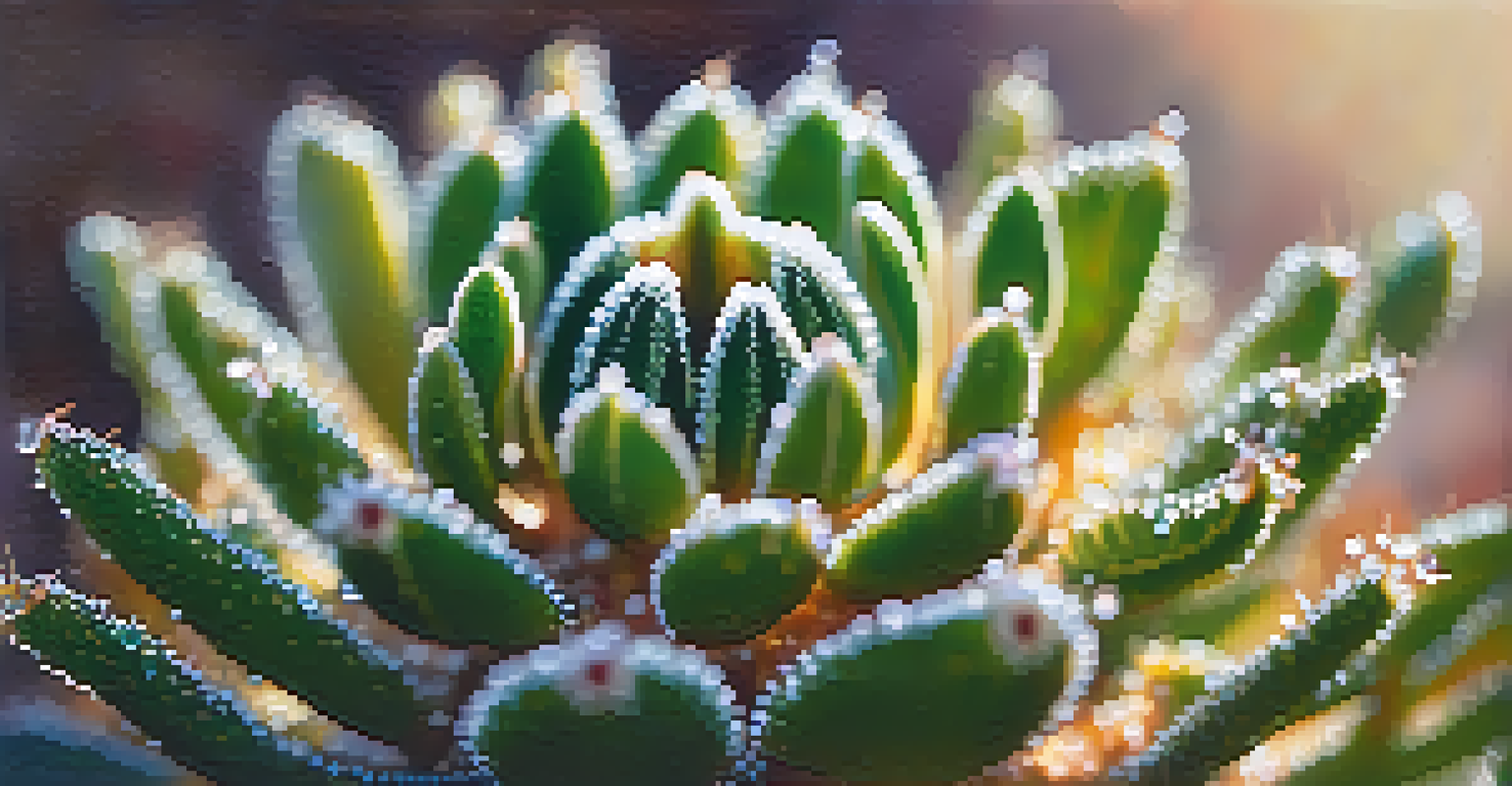Peyote and Shamanic Traditions: Healing Through Rituals

Understanding Peyote: A Sacred Plant in Shamanism
Peyote, a small cactus native to the southwestern United States and Mexico, has been used for centuries in indigenous shamanic traditions. Known for its psychoactive properties, Peyote contains mescaline, a compound that induces altered states of consciousness. These experiences are considered sacred, providing insights and healing that connect individuals to their spiritual roots.
The use of Peyote is not merely about the psychoactive experience; it is a journey into the depths of the soul, where healing and wisdom reside.
For many Native American tribes, Peyote is not just a plant; it is a revered teacher and guide. During rituals, participants consume the cactus to facilitate a deep introspective journey, often leading to profound personal revelations. This connection to the plant embodies a respect for nature and the spiritual world, emphasizing the importance of balance and harmony.
The ritualistic use of Peyote is deeply woven into the cultural fabric of various tribes, such as the Huichol and the Navajo. These ceremonies often involve music, dancing, and communal sharing, reinforcing the bond between participants and their ancestors. Such practices highlight the communal aspect of healing, where individual journeys contribute to the collective well-being.
The Role of Shamanism in Healing Practices
Shamanism is often described as an ancient healing practice that connects individuals with the spiritual realm. Shamans act as intermediaries, using rituals, songs, and plant medicines like Peyote to facilitate healing. Their role is to guide participants through their journeys, helping them navigate the complexities of their inner worlds.

In shamanic traditions, healing is viewed holistically, addressing the mind, body, and spirit. This approach contrasts sharply with modern medicine, which often focuses solely on physical symptoms. By integrating spiritual practices, shamans aim to restore balance and harmony within the individual, leading to lasting healing.
Peyote as a Sacred Healing Tool
Peyote is revered in indigenous cultures for its psychoactive properties, facilitating spiritual journeys and personal healing.
Moreover, shamanic rituals often include elements like drumming and chanting, which help induce trance states. This rhythmic accompaniment not only aids in the journey but also fosters a sense of community among participants. Such gatherings create a safe space for healing, where individuals feel supported and understood.
Peyote Rituals: A Pathway to Healing
Peyote rituals typically involve a series of steps designed to prepare participants for their journey. These may include fasting, prayer, and setting intentions, all aimed at creating a sacred space. Participants often gather in a circle, fostering a sense of unity as they embark on their personal explorations together.
In the circles of our ancestors, the plant was not just a teacher but a sacred bridge to the spirit world, offering insights that transcend time and culture.
During the ritual, the Peyote is consumed, and participants may experience vivid visions and heightened emotional states. These experiences can lead to emotional release, clarity, and insights that facilitate healing. The communal aspect of the ritual allows for shared experiences, where stories and lessons are exchanged, enriching everyone's journey.
Post-ritual integration is equally important, as participants reflect on their experiences and how they can apply their insights to daily life. This integration process often involves discussions with the shaman or other group members, helping individuals to contextualize their experiences and foster personal growth.
Cultural Significance of Peyote in Indigenous Communities
For many Native American tribes, Peyote holds immense cultural significance beyond its psychoactive properties. It is viewed as a sacred gift, integral to their spiritual practices and identity. The use of Peyote is often protected under the American Indian Religious Freedom Act, acknowledging its importance in cultural preservation.
The ceremonies surrounding Peyote are not merely personal experiences; they are community events that reinforce cultural ties. These gatherings provide an opportunity for elders to pass down knowledge and traditions to younger generations, ensuring the survival of their heritage. Through these rituals, the community strengthens its bonds and collective identity.
Shamanism's Holistic Healing Approach
Shamanism integrates mind, body, and spirit in healing practices, contrasting with modern medicine's focus on physical symptoms.
Additionally, the teachings derived from Peyote experiences often extend into daily life, influencing values, behaviors, and relationships. Participants frequently report a greater appreciation for nature, community, and spiritual connection after their journeys. This emphasis on interconnectedness reflects the broader worldview of many indigenous cultures.
Scientific Perspectives on Peyote and Its Effects
As interest in Peyote and psychedelics grows, scientists are beginning to explore the therapeutic potential of these substances. Studies have indicated that mescaline, the active component in Peyote, may help alleviate conditions such as depression and anxiety. This emerging research aligns with traditional shamanic practices that emphasize healing through altered states of consciousness.
However, it's essential to approach this research with caution. The effects of Peyote can vary widely among individuals, and not everyone may experience the same benefits. Moreover, the cultural context of Peyote use cannot be overlooked; what works in a ceremonial setting may not translate directly to clinical environments.
As scientists delve deeper into the potential of Peyote, it opens up conversations about the importance of integrating traditional knowledge with modern medicine. This collaboration could pave the way for new healing modalities that honor both the scientific and spiritual dimensions of health.
Ethical Considerations in Peyote Use
With the growing popularity of psychedelics, ethical considerations surrounding Peyote use have come to the forefront. Cultural appropriation is a significant concern, as individuals outside indigenous communities may seek to use Peyote without understanding its cultural context. Engaging with these practices requires respect and acknowledgment of their origins.
Furthermore, the sustainability of Peyote has become a pressing issue. Overharvesting and habitat loss threaten this sacred plant, prompting calls for conservation efforts. It's crucial for those interested in Peyote to support sustainable practices and honor the traditions surrounding its use.
Cultural Significance and Ethics
The use of Peyote is deeply embedded in cultural traditions, raising ethical concerns around sustainability and cultural appropriation.
Ultimately, ethical engagement with Peyote involves recognizing the deep cultural significance of the plant and the rituals associated with it. By approaching these practices with humility and respect, individuals can cultivate a more meaningful connection to Peyote and its healing potential.
The Future of Peyote in Healing and Spiritual Practices
As the interest in plant medicines continues to rise, the future of Peyote in healing and spiritual practices remains promising yet complex. There is a growing movement to integrate traditional shamanic practices into modern wellness frameworks, which could benefit many seeking alternative healing methods. This integration highlights the timeless wisdom found in indigenous cultures and their connection to nature.
However, the challenge lies in ensuring that these practices are respected and preserved. As more people become aware of the healing potential of Peyote, it is essential to safeguard its cultural heritage and ensure that indigenous voices are at the forefront of this dialogue. The future of Peyote should prioritize sustainability, respect, and genuine understanding.

In conclusion, Peyote and shamanic traditions offer profound insights into healing and spirituality. By embracing these practices with respect and intent, we can foster a greater understanding of the interconnectedness of all beings and the importance of community in the healing journey.